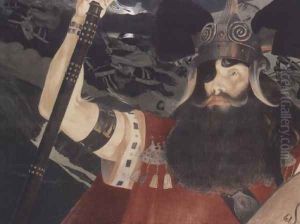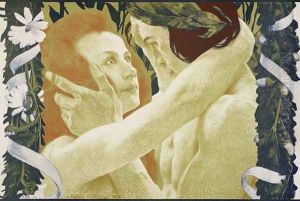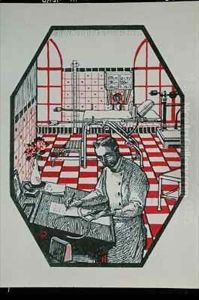Henri Jules Ferdinand Bellery-Desfontaines Paintings
Henri Jules Ferdinand Bellery-Desfontaines was born in 1867 in Paris, France, and emerged as a pivotal figure in the transition from Art Nouveau to the burgeoning Art Deco movement. His work, predominantly as a graphic artist, illustrator, and designer, bridged the gap between the ornate, nature-inspired motifs of Art Nouveau and the more geometric, streamlined aesthetics that would characterize Art Deco. Bellery-Desfontaines initially trained as a painter under Ernest Hébert and Félix-Joseph Barrias, but his career took a definitive turn towards the decorative arts, influenced by the prevailing tastes of his time and the opportunities presented by new technologies and materials.
Throughout the 1890s and into the early 20th century, Bellery-Desfontaines gained recognition for his poster designs, book illustrations, and furniture designs. His work for magazines, including the prestigious 'La Revue de l'Art Ancien et Moderne', showcased his versatility and his ability to infuse traditional themes with modern stylistic elements. He was particularly adept at integrating typographic and pictorial elements, creating cohesive, visually striking compositions. His illustrations often featured elaborate, fantastical landscapes and figures, drawing from mythological and historical themes but rendered with a modern sensibility that anticipated the simplification and abstraction of Art Deco.
As a designer, Bellery-Desfontaines was commissioned to create furniture and interior designs for several high-profile projects. His approach was holistic; he often designed not just the furniture but also the carpets, wallpapers, and lighting fixtures, aiming for a complete aesthetic experience. This comprehensive approach to design, considering every aspect of an interior as part of a unified whole, was a precursor to later developments in interior design.
Despite his significant contributions to the fields of graphic design and the decorative arts, Bellery-Desfontaines's career was relatively short-lived. He died in 1909 at the age of 42. His death marked the premature end of a career that was on the cusp of evolving further, potentially bridging other emerging styles and movements. Nevertheless, his work remains a testament to a transitional period in art history, capturing the shift from the organic, curvilinear forms of Art Nouveau to the more geometric, stylized forms that would dominate the early 20th century. His legacy is evident in the continued appreciation for his innovative designs and his role in shaping the visual culture of his time.



